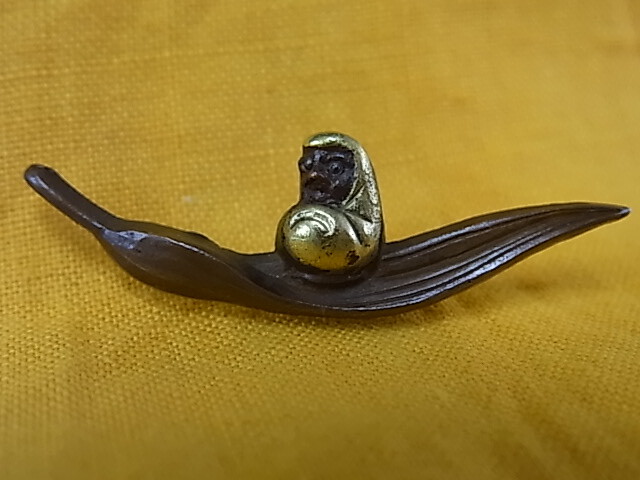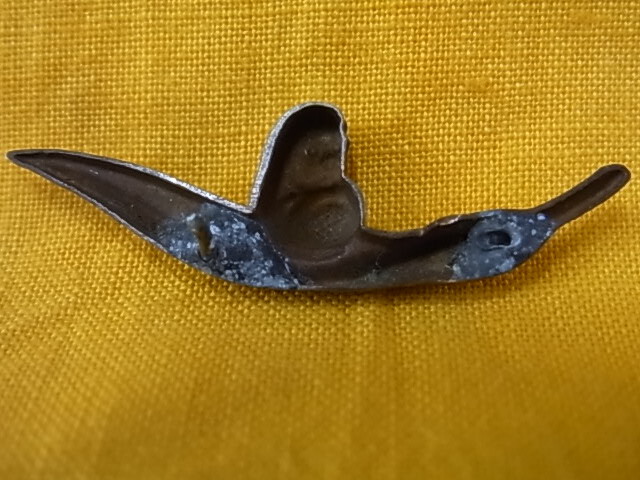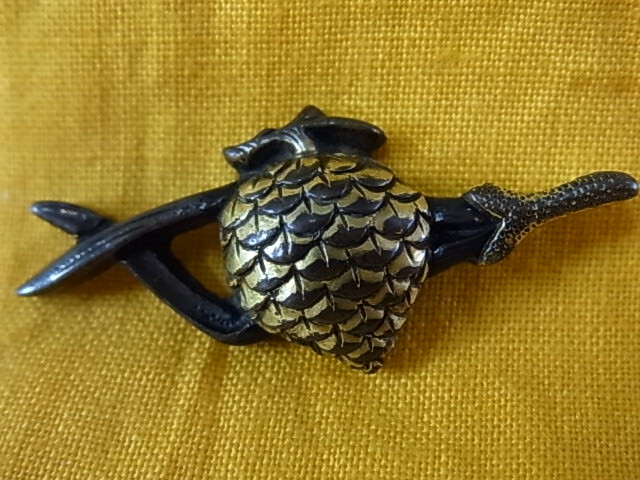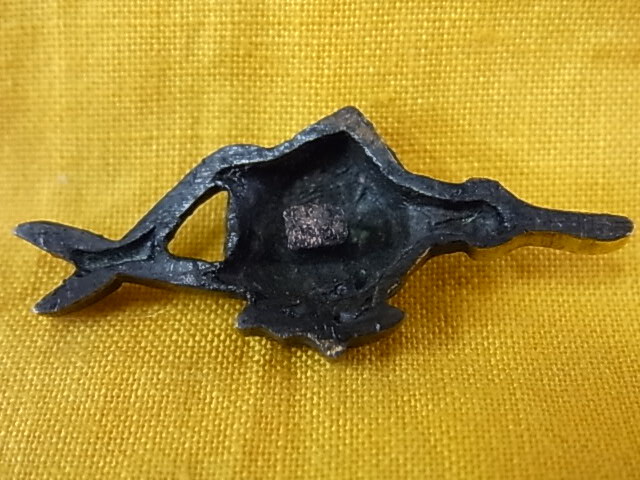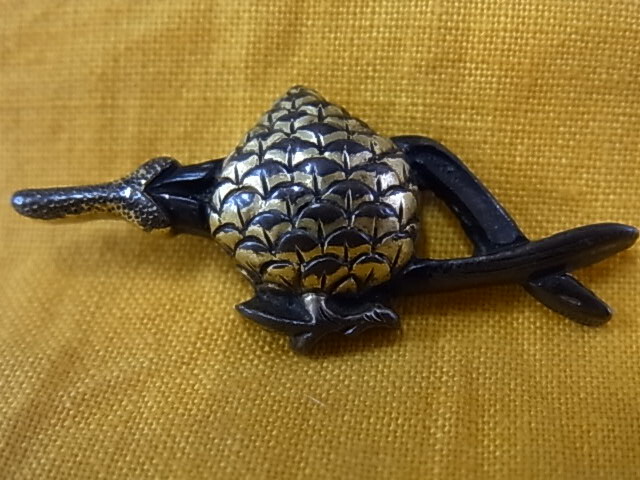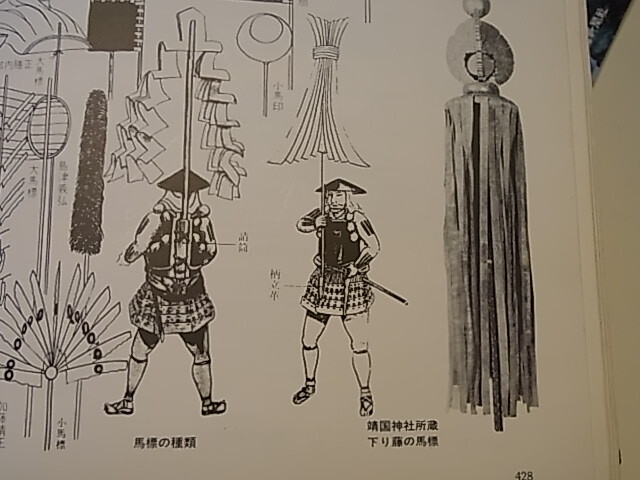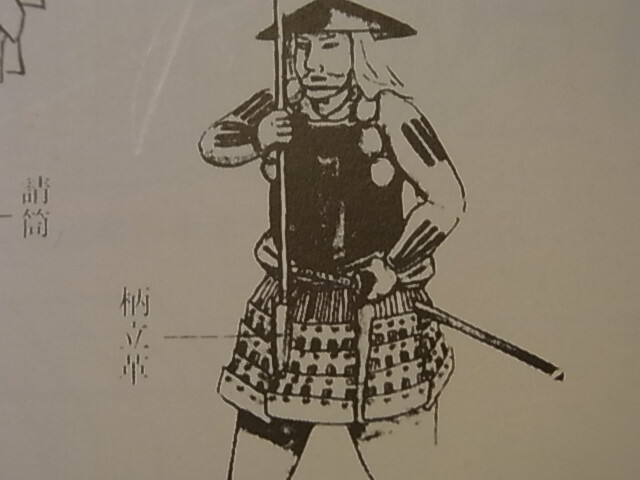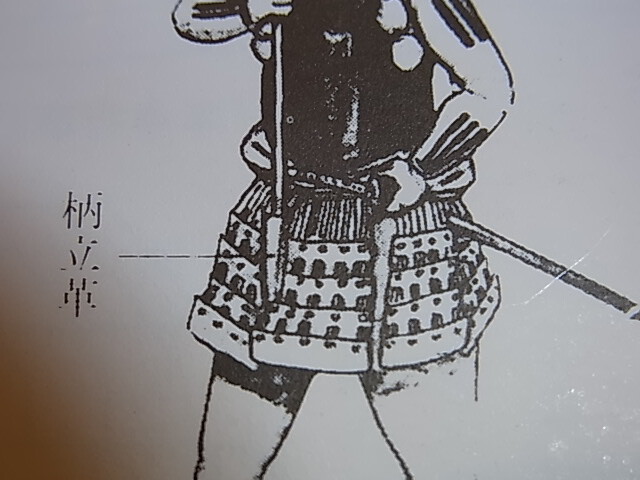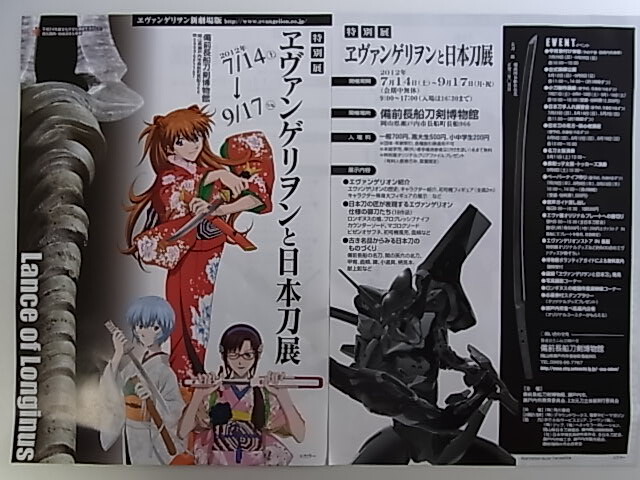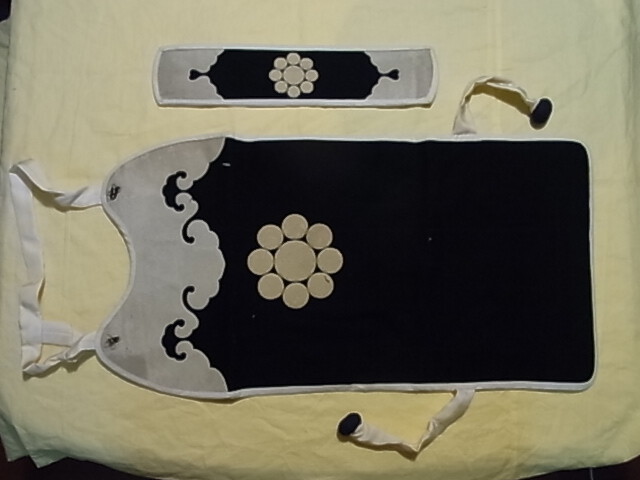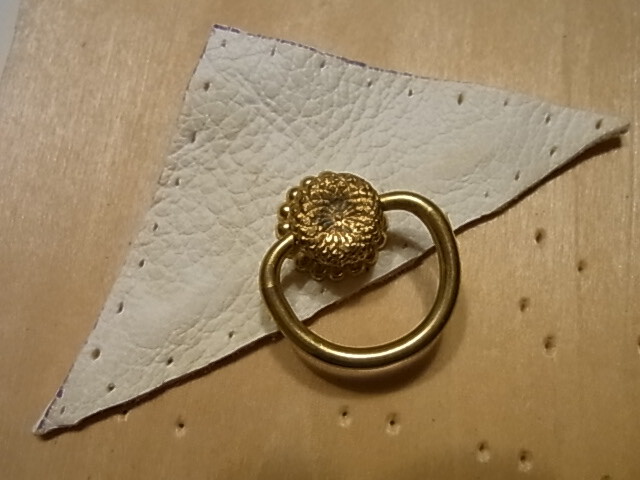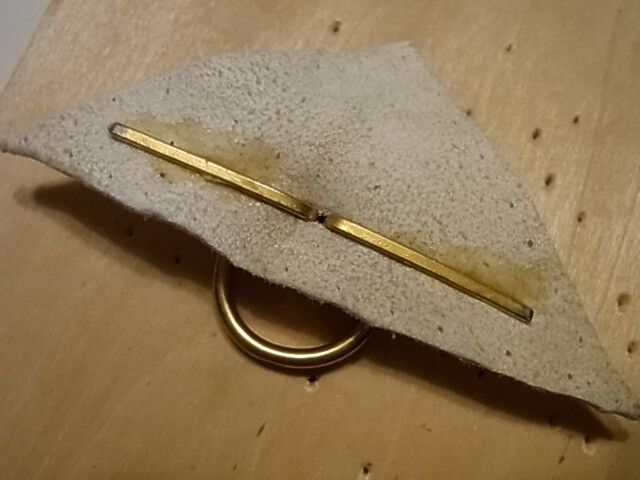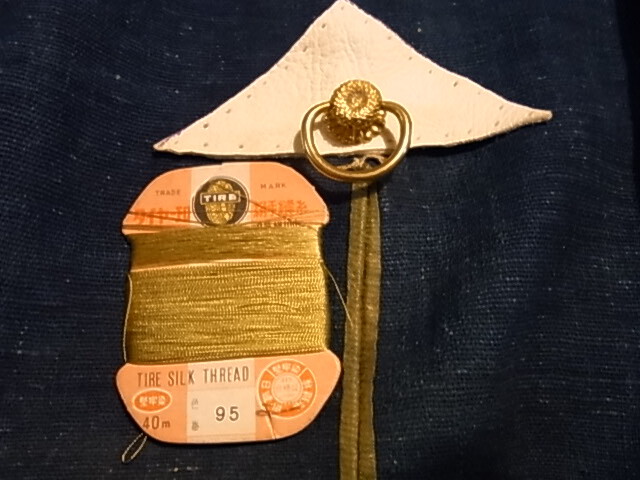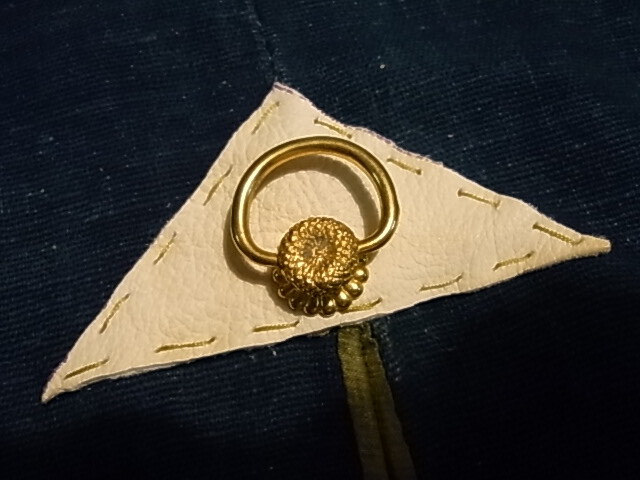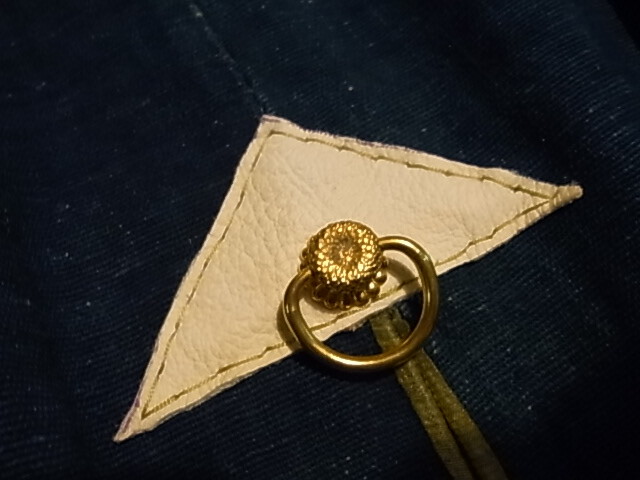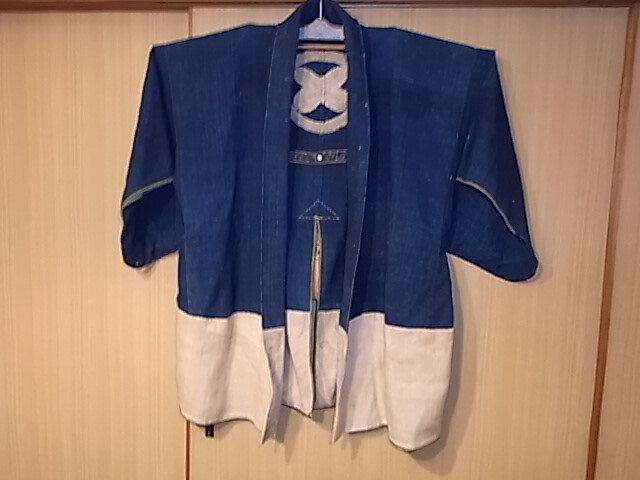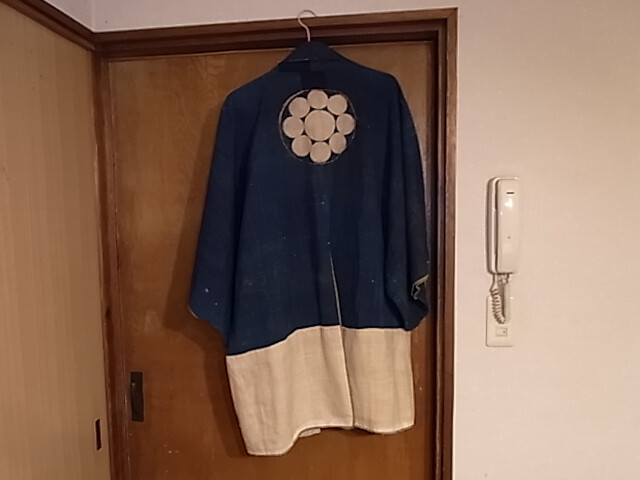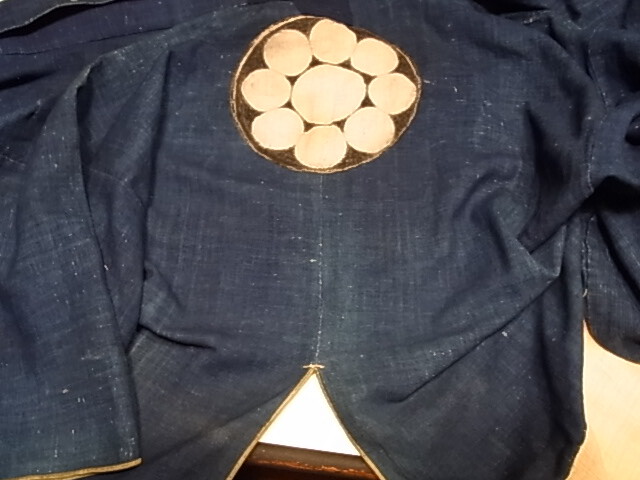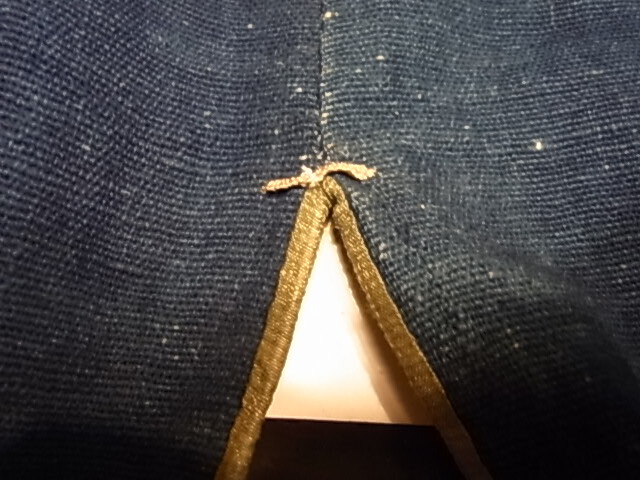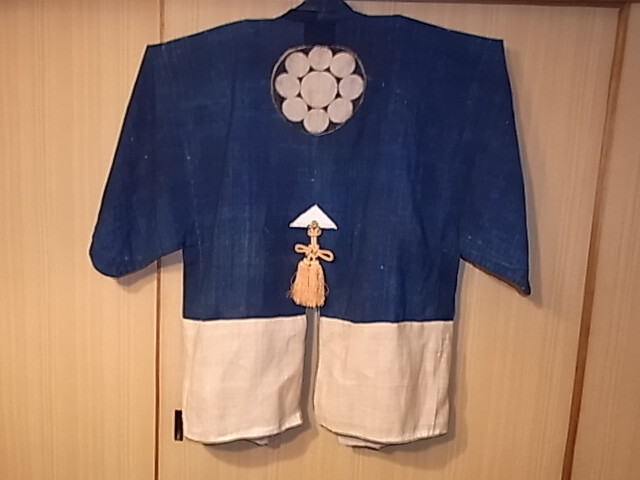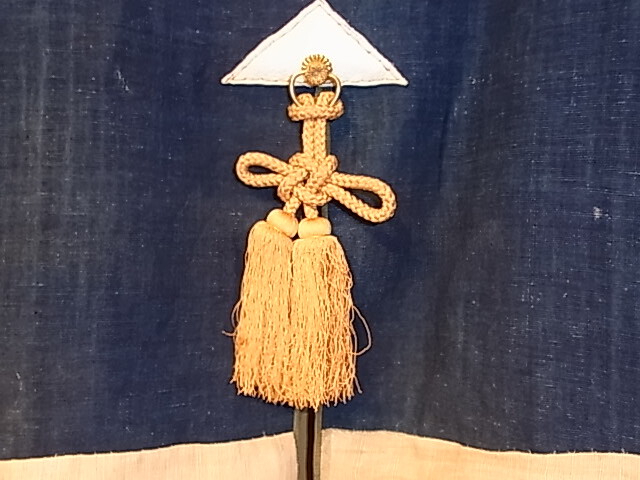-
Posts
13,676 -
Joined
-
Last visited
-
Days Won
246
Content Type
Profiles
Forums
Events
Store
Downloads
Gallery
Everything posted by Bugyotsuji
-
A clasp decoration for a purse usually has two wires soldered to the reverse, and these have been cut for freeing from an old and maybe useless pouch. This Mae-kanagu shows Daruma floating on a leaf. It is small and delicate and one wonders how it managed to scrape through relatively intact like this. The present examples of a Menuki and a Mae-kanagu were bought last Sunday from a dealer in sword fittings. Neither was bank-bustingly expensive, and there was not a huge difference in price. For those members who already knew all of this, apologies. Sometimes it takes me time to get my head around unspoken but obvious things!
-
Just for my own clarification I took the following shots to illustrate the difference between a Menuki and a Mae-kanagu purse clasp. We all know that in many cases the same artisan may have made both. They both appear for sale as a single item; often a single Menuki can be puzzling. Essentially a Menuki has a central (rectangular) protruding chunk on the back to help it fit flush against the tsuka, without slipping sideways in any direction. There may be no other evidence of fitting on the reverse. See pine needle and cone Menuki pics 1,2 and 3. NB Sometimes a Menuki might have been used in a new life as a purse clasp adornment, and it may bear witness of such in extra (soldered) pins on the reverse.
-
Actually if I just had the Japanese typed in readable Kanji, then I would be 90% happier. No need for an English translation! (Not just yet anyway...)
-
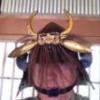
Replaceable Saya Liners
Bugyotsuji replied to Baka Gaijin's topic in General Nihonto Related Discussion
Just this morning a friend was showing me a wakizashi saya liner from the end of Edo, signed and dated Ansei I believe. In the bottom end of it just above the swivel pin were two rectangular recesses with an Ichibu Gin fitted neatly into each hollow. -
Thank you, Moriyama San. Sadly I cannot find a lacquer artist with such a Kanji (there were other "Kansai" 寛、貫 lacquer artists) who made Netsuke and presumably Inro, so it has a good ring to it, but I will keep looking. In the meantime here is another puzzle. It is a 煙管kisseru and Tonkotsu set, the tonkotsu being made of a single squashed section of bamboo. The final name, if there was one, may have been rubbed away, stopping at X雲哉? There is a poem(?) ending 雲表 on the lid, and an explanation(?) on the reverse? Apologies for the quality of the 銘 Mei photograph; the signature is very faint.
-

This Week's Edo Period Corner
Bugyotsuji replied to Bugyotsuji's topic in General Nihonto Related Discussion
Eric, try playing with Hitai-ate (forehead pad), or Tatami (folding) hitai-ate. http://www.iz2.or.jp/fukushoku/f_disp.p ... no=0000153 -
A different lacquer artist with a difficult name. Can anyone help with the first character? I think the second character is 哉 -sai, (kana).
-

The Kiseru and Tobacco in Japanese History
Bugyotsuji replied to watsonmil's topic in General Nihonto Related Discussion
Since Ron pointed out yet another chink in my armor/armour, I have spent the intervening time chatting with collectors and dealers about the difference between Menuki and Mae-Kanagu. It is now clear in my own mind. In celebration and in thanks to the dealer today who despite the searing heat had patiently pointed out the arcane detail, I sifted through a couple of trays and bought two, one of each. A wonderful Sambaso dancer caught my eye for many a long moment, but there is often sadly a limit to one's budget. There was also a lovely pairing of a lion and tiger in copper & shakudo with delicate silver claws, and on the back were both the original block for Menuki fitment, and the two pins for Mae-Kanagu. The dealer said that it had probably started life as a Menuki, had at some point been adapted for use on a purse, and finally been released to walk alone in the world. Perhaps I should have bought this one to show the membership here, but it was a toss-up between myself and my wallet, and the felines lost out. -

This Week's Edo Period Corner
Bugyotsuji replied to Bugyotsuji's topic in General Nihonto Related Discussion
Not willing to be caught writing on Friday the thirteenth! Ian, may thanks for the valuable thoughts. Lorenzo, how funny! I have heard that the spear is made of various alloys so as not to fall foul of the laws which would normally require such a thing to be legally registered and papered as a viable weapon. As to the date, let's do it. All I need now is the wife's permission. -

This Week's Edo Period Corner
Bugyotsuji replied to Bugyotsuji's topic in General Nihonto Related Discussion
Eric, compare that with this translation. 源氏車紋の道中羽織。腹当と帯がついており状態も良い。 Travel haori with Genji wheel Mon. Comes with bib "Stomach" cover (Japanese Hara-ate is a mistake and should be Muna-ate or Mune-ate) "Chest piece" (although it does indeed cover both chest and stomach!) and sash, in good condition overall. I am still wondering if there is really a difference, or is it simply the length of cloth attached to it that defines where it is tied? PS I have heard these described as Doh-chu Baori, which seems to indicate for Bushi to wear on trips eg Sankin Kotai to Edo and back. -
:lol: sorry about that, Ian! Do you have an English version of this book?
-
There is an illustration in Sasama Sensei's Nihon no Katchu/Bugu Jiten, on p. 428 of a pole-holder leather, E-tate-kawa 柄立革 which looks like a leather sheath affixed to the front of the obi, for carrying an uma-jirushi. It's a badly-printed drawing, but I will try and take a shot of it. Now if yours is an Etate, (but not a Kawa,) a Tsutsu or Ukezutsu, then we could be nearing the truth, although with that brass tang, I have to admit it could be a banner holder for a Bakumatsu/Meiji army, the holder clip to be slid onto a leather belt. (?)
-
Agreed with Ian there about the Daimyo Gyoretsu. Possibly for an uma-jirushi or large nobori-bata? Have you seen the chaps who juggle the long poles with fluffy tops? Very nice. I will show this to a few people if you don't mind, and see what feedback it might draw.
-

This Week's Edo Period Corner
Bugyotsuji replied to Bugyotsuji's topic in General Nihonto Related Discussion
I know many of the members must be perplexed and surely making a mental note to avoid Osafune this summer. Well, imagine the rift in the sword community there. Still, the museum was approached by a large organization last summer and it turned out to be a financial success, as well as an introduction and learning opportunity for many young people who would not otherwise have come into contact with their own culture directly like this. What is also interesting is to see otherwise serious members of the community who, once the decision was made to go ahead with this thing for better or for worse, have thrown themselves into making sure that it is a viable blend of old and new, and of reality and fantasy, which with something for everyone, will draw whole families to the event. http://image.search.yahoo.co.jp/search? ... E%E6%A7%8D -

This Week's Edo Period Corner
Bugyotsuji replied to Bugyotsuji's topic in General Nihonto Related Discussion
This is a link to the Evangelion event running from mid July to mid September at the Osafune Sword Museum. Several swords and a "Lance of Longinus" have been specially made by Bizen smiths for the event. http://axefactory.blog137.fc2.com/blog-entry-572.html (Eric, please don't be confused. Let's look at this slowly and rationally. I will try and get some exact measurements for the two bands.) -

This Week's Edo Period Corner
Bugyotsuji replied to Bugyotsuji's topic in General Nihonto Related Discussion
Oops, iPhone keyboard hard to use. No, the muneate and hachimaki I have had for some years and used them for my Shodan Shiken in ancient gunnery, Koshiki Hojutsu. They are old but my wife remade the borders. -

This Week's Edo Period Corner
Bugyotsuji replied to Bugyotsuji's topic in General Nihonto Related Discussion
Eric, this is another area where I need to study to find the answers. Firemen's clothes often have a stripe or band of a different color/colour in them. As to sleeves or lack of, I was talking rubbish earlier. There were sleeveless jinbaori through which you could show off your kote greaves. You earlier comment about how the new addition looks natural was a great compliment. Thanks, and good night! -

This Week's Edo Period Corner
Bugyotsuji replied to Bugyotsuji's topic in General Nihonto Related Discussion
-

This Week's Edo Period Corner
Bugyotsuji replied to Bugyotsuji's topic in General Nihonto Related Discussion
Ah, now that is excellent, Eric. My gun is a Kuyomon, so I like this pattern, although that one is described as a fireman's jacket. Now I am beginning to wonder about mine, ... :lol: In for a penny, in for a pound. Here are some intermediate shots. 1. The leather and ring fitment. 2. The stitching process -

This Week's Edo Period Corner
Bugyotsuji replied to Bugyotsuji's topic in General Nihonto Related Discussion
Eric, yes, there were/are many types of Haori, including the Kaji (firefighting) Haori that you mention. The over coat of a kimono can be called a Haori. I found in the dictionary that Jinbaori was usually an officer's over coat, with sleeves, and a slit at the back for the end of the sword saya to protrude through. There were versions including a lower ranked soldier's one called a Jinbei and another called a Kanbei. They usually have sleeves, but as you say, sleeveless ones can be called haori if they are a kind of over jacket. I bought this one for 5,000 JP yen some weeks ago, and my wife then spent many hours repairing the holes and rents in it. Well spotted. I supplied her with the Ai-zome (indigo) cloth for the patches. She applied a complete white section around the bottom as it was too far gone. It needs a final ironing as the natural folds have worked themselves out. She took 2,000 JPY off me for the work she did. The ivory button to close the front finger flaps took me about 3 hours to fashion; the old one was badly degraded. Boring two opposed tiny shallow holes in the back like Netsuke himotoshi holes took infinite patience and nerve. -

This Week's Edo Period Corner
Bugyotsuji replied to Bugyotsuji's topic in General Nihonto Related Discussion
To do this, you'll need to: See some pictures or actual examples of Jinbaori to see how it looked. Find some strong material, ie hemp cloth, or something like the piece of white leather that I used. Cut a triangle with some heavy scissors. Buy or requisition an agemaki cord with tassel, and the brass seat and ring (Kan). Use a punch to make holes in the leather for the needle and for the folding 'legs' of the Kan. Figure a way to stop the ring from swivelling left or right. Either sew the legs flat or use some kind of bond. Find some thread that color/colour matches something, in this case the green\gold border. Do double stitching all round, although I have not studied what stitching might have been best. (I am still considering whether to sew down the triangle corners more comprehensively, say with two loops for each corner.) This Jinbaori has no inner lining to it, so I simply stitched the triangle to the exterior, with no corresponding inner triangle, without worrying that the stitches will show through inside. The most difficult bit was attaching the agemaki without undoing the stiff cord and tassels. By loosening the bows of the knot I was able to gather enough extra into the top loop to push everything through it and then straighten out and tighten the 'Tombo Juji' bow knot. I was advised to burn the Kan with a cigarette lighter to add age to it, but at this point I hesitated. PS Photos available on request. -

This Week's Edo Period Corner
Bugyotsuji replied to Bugyotsuji's topic in General Nihonto Related Discussion
Well, here goes nothing. Cutting out all the intermediate steps, here are the before and after pics. -

This Week's Edo Period Corner
Bugyotsuji replied to Bugyotsuji's topic in General Nihonto Related Discussion
Some hours later. The project is finished, (apart from some ageing) but now I am wondering whether Jinbaori go under Katchu (yes, I know they go over Katchu! ) or whether I should file the report here. Today was magical. It's a long story, but the Osafune Sword Museum has been experimenting with unusual exhibits in order to draw more visitors. Last summer they did a "Sengoku Basara" Anime/Manga display mixed with real Sengoku armour/swords and they got 42,000 visitors, greater than the total population of Osafune. This summer it will be Evangelion, and we are to provide entertainment and again some weird and wonderful artefacts as background. Today we made a trip to Kansai to choose some Kawari Kabuto and unusual/rare menpo. I was overwhelmed by the variety out there. (Actually I was along for the ride and helped out carrying stuff...) A special "ロンギヌスの槍" "Lance of Longinus" has been fashioned and it will be auctioned off to the highest bidder, I believe. -

This Week's Edo Period Corner
Bugyotsuji replied to Bugyotsuji's topic in General Nihonto Related Discussion
You beat me to it, Eric. That is beautiful. Only just got back. In the car they were explaining that these things came along towards the end of Edo to decorate the back of the waist/belt. Many people see them and try to wear them as a Hachi-maki, but they are are too large and it looks funny, they were saying. I am just working on my travelling Jinbaori. You saw the replacement ivory button I made for it? The top of the sword slit at the back often used to rip upwards, so they had two or three ways of reinforcing the top of the divide. I have made a white leather triangle and fixed an agemaki-no-kan brass ring on a chrysanthemum base to it, and I was just about to start sewing when I saw your timely post! :D -

This Week's Edo Period Corner
Bugyotsuji replied to Bugyotsuji's topic in General Nihonto Related Discussion
Ate-obi? No Eric, I am sorry, although I think I have seen archers wearing something similar. When we go for Koshiki Hojutsu Shodan shiken, we wear Dogi with proper muneate and hachimaki. The Hakama has a stiff upright back section built into it. As to this Ate-obi, I will ask about it tomorrow as I am meeting a group of armor/armour experts and curators. (Unless Ian or someone answers first.)


